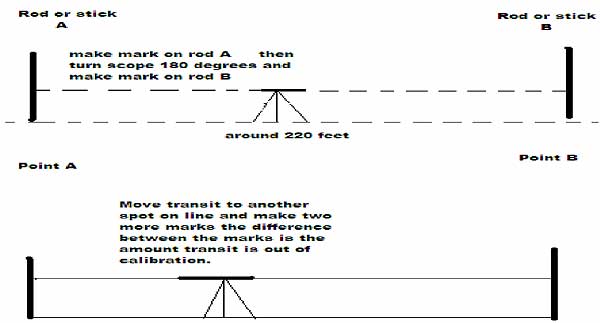Transit Definition = A surveying instrument used to measure horizontal and vertical angles.
Transit Setup
1. Setup tripod so head (TOP PLATE) is about level. This will make leveling the instrument easier. Drive tripod legs into the ground by stepping on each leg.
2. Release horizontal clamp screw and turn instrument until the telescope bubble is directly over a pair of leveling screws.
3. Turn both screws either toward or away from each other. One screw will then be loosened by the same amount that the other is tightened until bubble is level.
THE LEFT THUMB RULE STATES THAT MOVING YOUR LEFT THUMB TO THE LEFT…AS YOU MOVE YOUR RIGHT THUMB TO THE RIGHT…WILL CAUSE THE BUBBLE TO MOVE LEFT. MOVING YOUR LEFT THUMB TO THE RIGHT…WHILE YOUR RIGHT THUMB MOVES TO THE LEFT…WILL CAUSE THE BUBBLE TO MOVE TOWARD THE RIGHT
4. Turn the telescope 90 degrees until over the other set of leveling screws or when you have only three leveling screws then over the third screw and adjust.
5. Repeat the leveling procedure above alternating from one pair of leveling screws to the other until transit is level.
Transits
Checking Transit Accuracy
1. Set up transit in an area that is as level as possible and which is about 220 feet long. Place two matching level rods or two pieces of strapping in the ground about 200 feet apart with the faces toward each other. Position and level the instrument so that the distance from the instrument to each rod is the same measure.
2. Take a reading on each rod with the instrument (or mark each piece of strapping where the crosshair is sighted).
3. Move transit to another spot on the line and take readings and mark both rods again.
4. The difference between the marks on the rod will be the error of the instrument. The error needs to be corrected by a competent repair technician.

There are 360 degrees in a circle. Each degree is divided into 60 minutes. Each minute is divided into 60 seconds. So, 1 second it 1/3600 of a degree!
If someone says the error is 10 seconds that means the error of the transmitter could be +/- 1/16" at 100 feet from the transmitter.
At 200 feet, the error would be 2 times as much.
If the error were 15 seconds, it would be 1.5 times as much at 100 feet.
By starting with 10 seconds and 100 feet, you can easily compute the error.